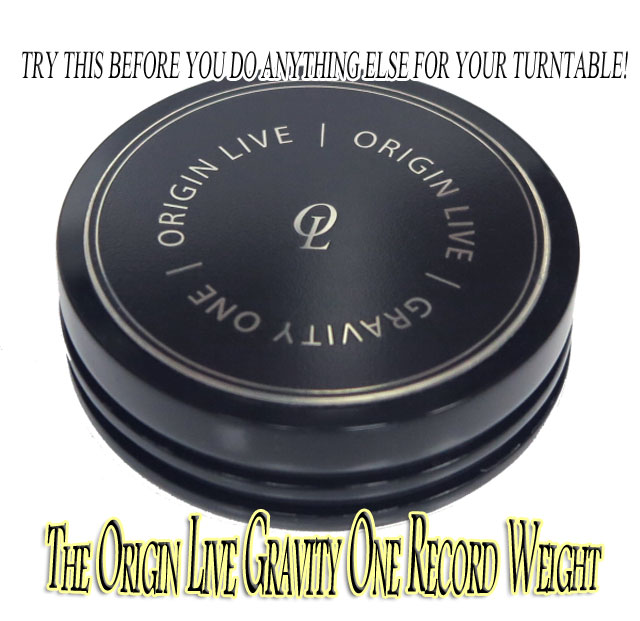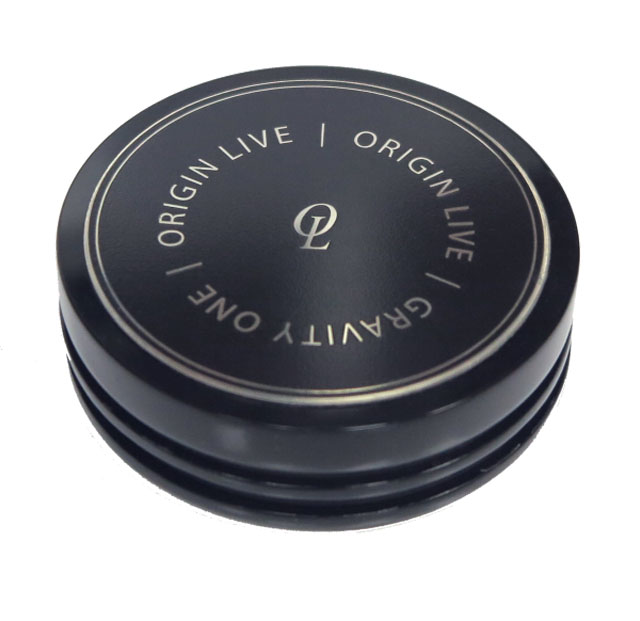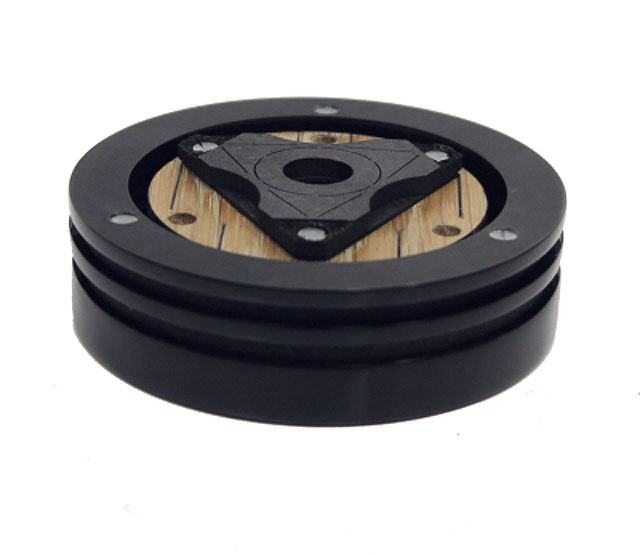The Origin Live Gravity One Record Weight by Paul Szabady

The record player has probably inspired more tweaks and modifications than any other single audio component. Indeed, one could argue that attempts to improve the sound of the turntable by alteration was the historical root origin of all the tweaks that audio enthusiasts routinely apply to all elements of their systems. Those with long memories and long residence on Planet Earth might trace the beginning of incipient tweakdom to barely post-pubescent teens of the 50’s and early 60’s taping a nickel coin to the top of the tonearm to stop their 45 RPM 7” Singles from skipping and sticking. More extreme cases required a quarter.
As the LP became dominant and one now owned a ‘turntable’ the impetus to tweak it resulted in an avalanche of products to ‘improve’ the table’s performance, not to mention all the home-brew attempts. The sheer number of these tweaks and the formal products developed to incorporate them runs on for pages – from playing the records underwater, to turntables equipped with vacuums to suck the LP flat to the platter, to simply attacking and encasing the table with pounds of modelling clay, Mortite, or the current incarnation BluTack. Every element of the turntable’s operation inspired numerous changes and modifications.
The charitably minded might see this impetus to tweak the turntable as perhaps inspired by an unconscious awareness of the horrifyingly difficult (impossible?) job the turntable has to do, but most likely it stemmed from the fact whatever you did to the turntable changed its sound. Whether it actually improved it was another matter.
I’ve often facetiously described the job of a turntable as trying to remove a mote from the eye of a flea, in the dark, from 10 miles away with a bamboo pole. Oh, and in a hurricane and during an earthquake and after drinking 37 cups of coffee. That Analogue LP playback works at all is amazing enough in itself. What is even more amazing is that, properly executed, it is still the standard bearer for accurate timbre and compelling artistic communication. In short, it makes music and can move one to a profound aesthetic level that even the best digital still fails to achieve.
 We know that the job of the turntable is to physically trace the minute vibrations cut into the record groove. The smallest of these are millionths of an inch, on the order of the lower wavelengths of light. The turntable must extract these exceedingly minute undulations of information without introducing any spurious and non-signal related vibrations of its own.
We know that the job of the turntable is to physically trace the minute vibrations cut into the record groove. The smallest of these are millionths of an inch, on the order of the lower wavelengths of light. The turntable must extract these exceedingly minute undulations of information without introducing any spurious and non-signal related vibrations of its own.
Say you’ve developed a perfectly rigid tonearm that doesn’t resonate, a drive system that doesn’t introduce any motor vibration into the platter, runs at perfect speed, and has a perfectly silent bearing. Further, say you have a perfect flawless phono cartridge with a stylus that can extract all the information cut into the grooves. Would the result be perfection?
Most probably not. The force generated in the record groove by the record moving past the stylus creates forces of incredible chaotic power. This physical vibration of the vinyl LP as it is tracked creates non-music related vibrations that seriously degrade the integrity of the signal. Remember our friend the flea and the 10-mile long bamboo pole of my sarcastic simile? Imagine now that the flea is hopped up on meth, is having a manic episode, won’t stand still, and keeps moving its head and blinking. Taming those spurious vibrations is what Origin Live’s Gravity One Record Weight is designed to do.
The Record Weight could just as easily have been called the Record Light Weight, as it differs from most other record weights in that it is almost feather light. Further, it makes no attempt to clamp the record to the platter. Thus, it creates no untoward side-effects on the table’s platter bearing and record spindle and is, in fact, isolated from them. Its light weight means that it won’t compress or deform any platter mat one is already using, and it can also be used on a bare platter. The Gravity One Record Weight costs $196 and comes with a money-back guarantee.
It only took a brief audition on 9 of my turntables to realize that I would NOT be sending this superb product back.
Apotheosis (definition): elevation to divine status. Deification. Quintessence.
Transmogrify (definition): To change or alter greatly, often with grotesque or humorous affect. Transform.
Teacher: “Apply these 2 terms in one complete sentence, please.”
Reply: “The Origin Live Record Weight so transmogrifies the sound quality of a given turntable’s performance that one concludes that one is hearing the apotheosis of that turntable.”
My turntable stable has now grown to 10 and runs the gamut from ‘barely adequate’- OK, inadequate – (a Technics SL 1500 Direct-Drive,) through the Forgotten Classic Connoisseur BD2A, to 2 Linn Sondek LP 12’s (one an early original sample only upgraded with Linn’s Nirvana spring/grommet kit,) on through to a Merrill-modified AR XA, and then on to 5 Origin Live turntables, culminating in my ultimate reference -the Origin Live Resolution MK4 with OL’s Enterprise 3C arm. Each table is mounted with a different cartridge, tweaked to its finest by careful set-up, isolation devices, and best-sounding mat, and run through a different phono stage. Seven of these tables can be auditioned in my Main Reference System at the flick of a switch. Two others are used in two separate systems in 2 other rooms.
The Origin Live Record Weight worked with all 9 of the front-ends I auditioned, its effect slightly varying with the ultimate capabilities of each one and related to how well each Front-End had been completely sorted. The Record Weight had a massive effect on each and every turntable, from the weakest (the Technics Direct Drive) to the most sublime. In each case the change was so great that I couldn’t avoid the notion that it was releasing the Front-End’s full inner potential. The Record Weight’s effect was cosmic in both the figurative and literal senses of the word: immense, significant, and overwhelming, while also creating an intensely communicative ordered musical world. All this from a light-weight puck 3 inches wide by 1 inch high.
Mark Baker of Origin Live is a master of damping and resonance control. Even his least expensive turntable – the Aurora – eschews the need of even the most state-of-the-art isolation devices. The stellar performance of his tonearms is also due to his sophisticated understanding and application of resonance control. Moreover, he has consistently shown the ability to think beyond convention and dogma.
 He is also aware that brute-force damping is unnecessary. Strike a wine glass, a thin steel mixing bowl, or a Triangle, let it ring, and then gently touch the item with a finger. It takes only the lightest of touches to stop (damp) the resonance. Every musician who plays a string instrument is aware of just how much force is necessary to create different resonance effects. It’s part of their artistic performance arsenal – their sense of touch. You don’t need to grab the string with a lead-filled boxing glove.
He is also aware that brute-force damping is unnecessary. Strike a wine glass, a thin steel mixing bowl, or a Triangle, let it ring, and then gently touch the item with a finger. It takes only the lightest of touches to stop (damp) the resonance. Every musician who plays a string instrument is aware of just how much force is necessary to create different resonance effects. It’s part of their artistic performance arsenal – their sense of touch. You don’t need to grab the string with a lead-filled boxing glove.
Similarly, once the Triangle, wine glass, or mixing bowl is lightly touched, striking it again does not produce the same sound as the undamped strike. Its pitch is now far lower and as one grips even tighter it takes stronger and stronger strikes to initiate and to hear the resonance.
My own long experience (gained in over 25 years in the retail trade) with various record clamps, vacuum-based turntable platters, and other record weights in the past was that while they could improve the sensation of bass heft, they also deadened the dynamics of the midrange and high frequencies, leading to an overall loss of musical brio and rhythmic thrust. They changed the sound but negatively affected the music. I dumped a drawer-full of record weights and clamps when I discovered the Ringmat over 25 years ago. The complete Ringmat LP Support System includes what they call the Top Cap, a miniature Ringmat, constructed of special parchment and cork rings that is placed on top of the record label to damp any subtle residual vibration. While not perfectly effective, its use allowed the tracking of the subtlest and delicate of dynamic changes and also recreated the relative volume of each instrument playing more exactly, and with greater musical communication than any heavy-handed, heavyweight blunderbuss I’d encountered during those 25 years. So, I was no stranger to the potential of a light touch to damping.
The Gravity One Record Weight uses a complex system of damping devices that can be partially gleaned by looking at its bottom into its internals. A combination of damping polymer material that looks similar to that used in Origin Live’s Record Mat and their Cartridge Enabler, a thin wedge of an un-named wood strategically incised with delicate etched patterns, and carefully placed and tightened screws hint at the sophistication and complexity of the device. It must have been a nightmare to design and develop.
A simple rude and crude test for the OL Record Weight is to play a record with the volume turned completely off. One can hear a kind of high-ish frequency needle talk and needle noise emanating from the record. (Shades of Thomas Edison’s original sound machine.) Add the Record Weight and the noise disappears. Most impressive.
Common to all my auditions was a significant lessening of distorted ‘hash’ throughout the entire frequency spectrum, but most obviously audible in the treble. High frequencies emerged with a purity and clarity that evoked the similarity of moving from a thick and slow aluminum cantilever with an indifferently glued-on elliptical stylus to the finest gem cantilever and the most sophisticated line-contact stylus.
 Transient response was tracked far more accurately, revealing tighter, clearer, fuller, and more dynamic bass response. The formation of instrument image outlines became more visual. False brightness was banished while percussion clarity was improved in both rhythm and dynamics. Midrange gains, aided by the reduction in high-frequency hash, were equally significant – instruments more faithfully exhibiting their sonic signatures, while vocals gained in articulation, with lyrics far easier to hear. The improvement in transient response benefits all instruments and all aspects of music – from dynamic range, depiction of instrumental timbre, the creation of a sound stage and instrumental placement on it, to timing and rhythm and melodic flow.
Transient response was tracked far more accurately, revealing tighter, clearer, fuller, and more dynamic bass response. The formation of instrument image outlines became more visual. False brightness was banished while percussion clarity was improved in both rhythm and dynamics. Midrange gains, aided by the reduction in high-frequency hash, were equally significant – instruments more faithfully exhibiting their sonic signatures, while vocals gained in articulation, with lyrics far easier to hear. The improvement in transient response benefits all instruments and all aspects of music – from dynamic range, depiction of instrumental timbre, the creation of a sound stage and instrumental placement on it, to timing and rhythm and melodic flow.
The overall impression cast was one of far greater fidelity, more natural depiction of instrument sonority, along with increased communication of the music and the quality of the performers’ art. Rather than bore you with details of how each turntable/arm/cartridge/phono stage (that you likely don’t own,) playing LP’s (that you might not know,) sounded, the simplest solution is to audition it yourself. One experience is worth 10,000 words. There’s no risk with Origin Live’s money-back guarantee. The Record Weight can be ordered from the Origin Live website’s on-line store. (please note: OL’s store shows UK prices in Pounds, which include 20% VAT. Subtract 20%, and convert to US dollars or other currencies to get the applicable price.)
The Record Weight is not a magic wand that banishes all the problems encountered in Analogue LP playback. It effectively makes the job of the arm and cartridge/stylus far easier. It won’t, however, change a pig’s ear into a silk purse. Excessive record wear and groove damage, inaccurate set-up of arm and cartridge, and grossly inadequate inherent turntable/arm design will not be glossed over.
We all try to optimize our Front-Ends (we’ve come a long way conceptually from simple ‘record players’) to effectively deal with LP playback’s difficulties. In effect, our Front Ends become a cosmos: an ordered world with each element hopefully working harmoniously with all the others. The OL Record Weight can seriously upset each established Front End’s cosmos and force a re-think of its elements. I know that I had to check and re-adjust VTA/SRA, change interconnect choices from phono stages, and re-evaluate turntable mats to fully integrate the new cosmos the Record Weight initiated.
Origin Live has been one of the most creative, fertile, and prolific companies of the current Millennium. The firm’s products’ exceptional music-making success is due to Mark Baker’s relentless pursuit of perfection coupled to his unique design intelligence and creativity. While he has pursued ultimate no-compromise, cost-no-object products (the Origin Live Voyager turntable at $21,168 and the Renown $24,192 tonearm,) he has also produced exceptionally affordable products that fit nearly any budget. Some of Origin Live’s crazily effective affordable accessories include turntable drive belts, bearing oil, and the ultra-cheap and ultra-effective Cartridge Enabler. The Record Weight joins this list. The simplest test for any ‘tweak’ is to remove it. After a week’s acclimation to the improvements wrought by the Record Weight, living without it proved impossible. In fact, the Record Weight moves out of the category of Tweak or Accessory and becomes a fundamental necessity. The highest of recommendations.

![]()
paul szabady
LIST OF FRONT-ENDS AUDITIONED
– Technics SL 1500 with Funk Firm Achromat, Grado Gold and Audio Technica AT VM95 ML cartridges into phono section of AMC CVT 1030 tube preamp. Townshend Seismic Sink Air Isolation platform.
– Connoisseur BD2A turntable w/ SAU2 tonearm, Garrott Brothers Fritz Geiger Signature stylus upgrade of Goldring Eroica LX low-output mc cartridge into EAR 834P tube preamp. Townshend Seismic Sink. Ringmat replacement mat and Top Cap.
– Linn Sondek LP12 classic, original with only Nirvana upgrade spring kit. Funk Firm Achromat, Origin Live RB 250 tonearm, Sumiko Blue Point #2. Origin Live bearing oil and Upgrade belt. Graham Slee Reflex M phono stage.
– Linn Sondek LP 12 w/ Origin Live DC motor conversion with Upgrade Transformer. Origin Live bearing oil and OL Upgrade belt. Funk Firm Achromat. Origin Live RB 250 and Nagaoka MP 500 into puresound P10 tube phono stage.
– Merrill-modified AR XA with one-piece acrylic sub-chassis and arm-mount boss. Origin Live RB 300, Shure V-15 V xMR w/ JICO neo-SAS stylus. Sumiko Acrylic Mat w/ Analogue Survival Kit gauze platter damper. Origin Live bearing oil. Ringmat and Top Cap. Townshend Seismic Sink. Musical Surroundings Phonomenon.
– Origin Live Aurora MK II with OL bearing and belt upgrades, OL Silver MKII arm with LP Gear BIN 323 HOMC into phono stage of Hegeman HAPI ONE preamp. OL platter mat and Ringmat. Origin Live Cartridge Enabler.
– Origin Live Aurora MKII w/Upgrade Transformer and belt and bearing oil upgrades. OL mat with Ringmat and Top Cap, Origin Live Onyx arm with Audio Technica AT OC9 ML LOMC into Origin Live Discovery 2.
– Origin Live Aurora Gold w/ Upgrade transformer, belt and bearing oil. OL Conqueror MKII tonearm w/ OL Cartridge Enabler, Sumiko Talisman Boron MC, Graham Slee Accession MC. Townshend Seismic Sink.
– Origin Live Resolution MK4 with OL Enterprise 3C tonearm. Cartridge Man Music Master cartridge. OL mat. Ringmat Top Cap and Stat Cap. Graham Slee Accession MM phono.
Origin Live
Unit 5 362B Spring Road
Southampton
Hampshire
SO19 2PB
UK
Phone: +44 (2380) 578 877
Email: originlive@originlive.com
Website: https://www.originlive.com/
Record Weight and Online Store : https://www.originlive.com/hi-fi/turntable-upgrades-modification/turntable-record-weight-best/
Stereo Times Masthead
Publisher/Founder
Clement Perry
Editor
Dave Thomas
Senior Editors
Frank Alles, Mike Girardi, Key Kim, Russell Lichter, Terry London, Moreno Mitchell, Paul Szabady, Bill Wells, Mike Wright, Stephen Yan, and Rob Dockery
Current Contributors
David Abramson, Tim Barrall, Dave Allison, Ron Cook, Lewis Dardick, Dan Secula, Don Shaulis, Greg Simmons, Eric Teh, Greg Voth, Richard Willie, Ed Van Winkle, and Rob Dockery
Music Reviewers:
Carlos Sanchez, John Jonczyk, John Sprung and Russell Lichter
Site Management Clement Perry
Ad Designer: Martin Perry








Be the first to comment on: The Origin Live Gravity One Record Weight by Paul Szabady